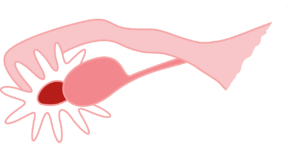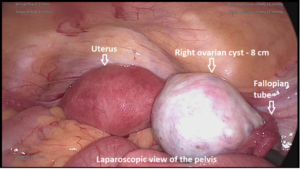 The ovaries are the female reproductive organs that contain eggs and will release them on a regular basis (usually monthly in the majority of the women). It also produces female and male hormones. An ovarian cyst is abnor¬mal growth in the ovary and can be either solid or cystic. It can be divided into either a benign (non-cancerous) or malignant (cancerous) type. Benign or non-cancerous cysts do not invade neighboring tissue the way malignant cyst does. The exceptionally large ovarian cyst often turns out to be benign.
The ovaries are the female reproductive organs that contain eggs and will release them on a regular basis (usually monthly in the majority of the women). It also produces female and male hormones. An ovarian cyst is abnor¬mal growth in the ovary and can be either solid or cystic. It can be divided into either a benign (non-cancerous) or malignant (cancerous) type. Benign or non-cancerous cysts do not invade neighboring tissue the way malignant cyst does. The exceptionally large ovarian cyst often turns out to be benign.
The term ovarian cyst refers to abnormal growth in the ovary that contains mainly fluid, although occasionally some solid component may be present as well.
Symptoms and signs
Many women with ovarian growths do not have symptoms and is only detected during routine screening. Some may present with the following symptoms:
- Mild pelvic pain.
- Pain in the lower back.Discomfort with sexual intercourse.
- Abnormal menstruation, including changes in menstrual flow, length of bleeding and intervals between periods.
- If a large ovarian cyst twists or ruptures, the following will occur in the lower abdomen—severe pain, tender lower abdomen, and swelling.

- Some ovarian growth may produce excessive hormones and the clinical effects will depend on the type of hormones that are being produced such as:
Effects of excessive female hormones – present with abnormal menstruation, precocious puberty (early onset of puberty in young girls)
Effects of excessive male hormones – present with acne, oily skin, increased male type of hair distribution, hoarseness of voice, breast atrophy, clitoral enlargement.
Types of cysts
Common types of benign ovarian cysts are:
- Endometriotic cysts
- Dermoid cyst (mature cystic teratoma)
- Cystadenoma
 Some ovarian cysts may arise from a normal physiological process, such as a corpus luteal cyst that develops following ovulation. Bleeding may occur into this cyst or into the pelvic area, causing pain. If bleeding occurs into this cyst, it will be labeled as haemorrhagic corpus luteal cyst. If the bleeding spills into the pelvic cavity, it is called a ruptured corpus luteal cyst. The pain is usually acute and of variable intensity. The bleeding can be variable, from minimal to a large volume, leading to admission and possible surgical intervention. If symptoms are mild, surgery is unnecessary and can be managed with painkillers and rest. These cysts will usually resolve spontaneously following the next menstrual cycle.
Some ovarian cysts may arise from a normal physiological process, such as a corpus luteal cyst that develops following ovulation. Bleeding may occur into this cyst or into the pelvic area, causing pain. If bleeding occurs into this cyst, it will be labeled as haemorrhagic corpus luteal cyst. If the bleeding spills into the pelvic cavity, it is called a ruptured corpus luteal cyst. The pain is usually acute and of variable intensity. The bleeding can be variable, from minimal to a large volume, leading to admission and possible surgical intervention. If symptoms are mild, surgery is unnecessary and can be managed with painkillers and rest. These cysts will usually resolve spontaneously following the next menstrual cycle.
 Causes
Causes
- Usually unknown but may be related to abnormalities of female hormone production and secretion.
- Endometriosis.
Prevention
There are no specific or effective preventive measures at the moment. The use of combined oral contraceptives pills may help to decrease the risk.
Complications
- Sudden onset of severe abdominal pain, either due to rupture, bleeding or twisting of the ovarian cyst. This would require an emergency abdominal surgery.
- Progressive enlargement, requiring open surgery and a larger incision.
- Cancerous change
 Investigation and diagnosis
Investigation and diagnosis
- A cervical cytology smear (Pap smear) is routinely advised for women who are at risk if it has not been done recently.
- Diagnostic tests include laboratory blood studies.

- Ultrasound scan is required for diagnosis and to help determine the nature and type of ovarian growth. In some cases, a CT scan or MRI may be recommended. These imaging modalities will be useful to decide the best management plan.
Treatment
- Treatment may not be necessary for those who are without any symptoms and the ovarian cyst is small. Regular follow-up is advised so that the size and growth of the cyst can be monitored via ultrasound scan.
- Some cysts require surgery to diagnose accurately, to rule out cancer, or for definitive treatment purposes. For most benign ovarian growths, the operation of choice is cystectomy. This is a procedure whereby only the growth is removed while retaining the ovary. This is recommended only if the growth is benign and the woman is young. However, the whole ovary (together with the growth) may need to be removed if there is suspicion of cancer or the ovary is no longer healthy due to various reasons (such as twisting of the ovary causing gangrenous change or infection). If one ovary must be removed, normal conception and childbirth is possible as long as a normal ovary remains on the other side. The approach to cystectomy alone or removal of the ovary can be either via laparoscopy or laparotomy.

- Laparoscopy – This is the procedure of choice if it is feasible. Laparoscopy (telescope inserted through the navel) is a minimally invasive surgical procedure that can diagnose and treat ovarian cysts at the same time. Instruments are inserted through additional tiny incisions in the abdomen and are used to cut and remove the cyst. Click here to read more about it.
- Laparotomy – this is a surgical opening made into the abdomen. The skin incision is much longer than laparoscopy. It is indicated in the following circumstances: if the ovarian cyst is very big, when there is a previous operation making laparoscopy risky or when there is suspicion of cancer.
- Combined oral contraceptives pills can be prescribed and may help shrink the cyst, particularly those physiological cysts that are related to ovulation.
- There are no restrictions on activity or diet unless surgery is necessary.
See your doctor immediately if there is:
- Sudden onset of severe abdominal pain, with or without abdominal distention.
- Progressive abdominal swelling.
- Poor appetite, abdominal discomfort, nausea or vomiting, significant weight loss.
To download and print a pdf copy, CLICK HERE
To read more about laparoscopic surgery, CLICK HERE
To view videos of laparoscopic surgery for endometriosis, CLICK HERE
To view videos of laparoscopic surgery for other types of ovarian cyst, CLICK HERE
To subscribe and receive the newsletter, CLICK HERE






